In August 2022, the total trading volume of CEA was 547,987 tons, with a total turnover of 30.74 million yuan
1. National carbon market and trading information
1. Overall monthly situation in August
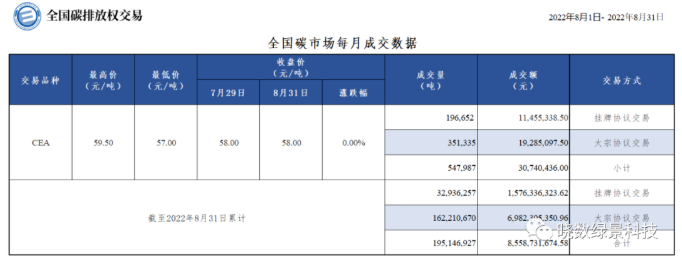
This month, the total trading volume of carbon emission allowances (CEA) in the national carbon market was 547,987 tons, with a total turnover of 30,740,436.00 yuan.
The monthly trading volume of the listed agreement was 196,652 tons, the monthly turnover was 11,455,338.50 yuan, the highest transaction price was 59.50 yuan/ton, the lowest transaction price was 57.00 yuan/ton, and the closing price on the last trading day of this month was 58.00 yuan/ton, which was the same as the last trading day of the previous month.
The monthly trading volume of block agreement transactions was 351,335 tons, and the monthly turnover was 19,285,097.50 yuan.
As of this month, the cumulative trading volume of carbon emission allowances (CEA) in the national carbon market was 195,146,927 tons, with a cumulative turnover of 8,558,731,674.58 yuan.
2. Trading trend and analysis of the carbon market in August
The actual price trend of carbon emission allowances (CEA) in the national carbon market this month is used as an example to analyze the operation of the Xiaoshu carbon price index. The chart below is the analysis of the trend of carbon prices and the analysis of carbon market transactions from August 1, 2022 to August 31, 2022.
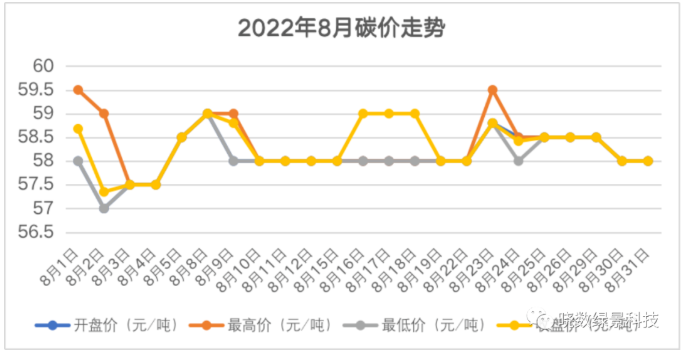
According to the actual trading data of the carbon market, the first few days of this month fluctuated slightly, and tended to stabilize in the middle and second months, although the national carbon market fluctuated slightly, but the overall float was around 58.5, there was no obvious change trend, and the carbon price trend was stable.
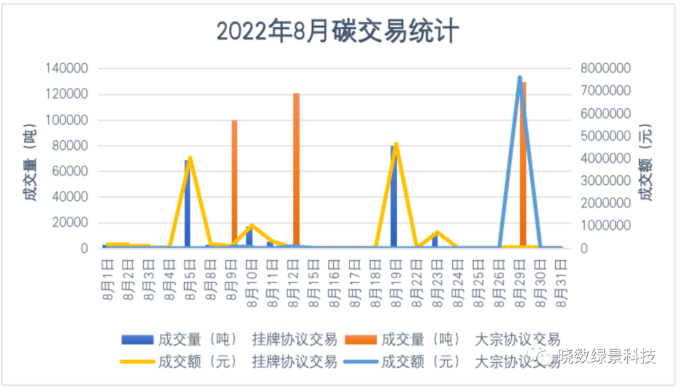
In terms of trading volume, the average daily trading volume of CEA in the national carbon market this month was 23,000 tons, a significant decrease from 43,000 tons in July. Bulk trading is still the main position of carbon trading, with three transactions exceeding 100,000 tons. The situation of international relations between China and the United States and the recurrence of the epidemic are all reasons for the impact on the carbon market. There are all transactions on weekdays this month, but the trading volume is still small, the atmosphere is relatively deserted, and there is still a big gap between the 500% turnover rate of the European Union and the 5% turnover rate in China.
2. Domestic local carbon market and trading information
1. The overall situation of Beijing's carbon market
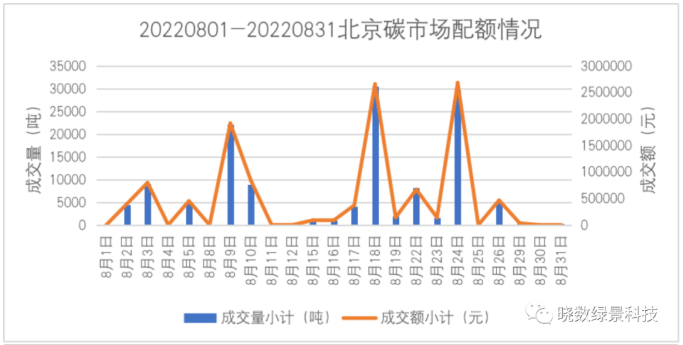
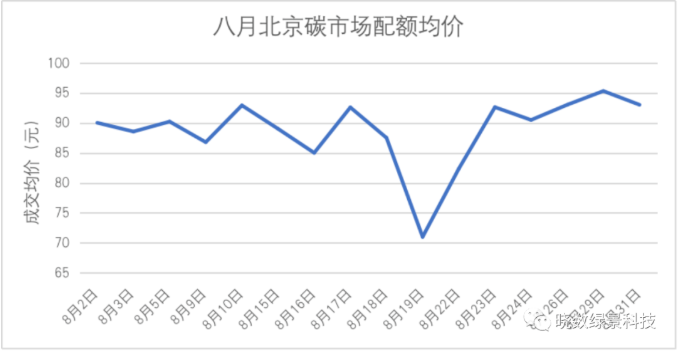
Beijing's quota trading volume this month was 362529 tons, and the turnover was 11719184 yuan, ranking first in the country, and there were seven working days without trading. The average price of Beijing quota in August was 88.76 yuan, an increase of 4.13 yuan or 4.88% month-on-month compared with the average price of 84.63 yuan in July. Compared with 64.99 yuan in the same period last year, it increased by 23.77 yuan, a year-on-year increase of 36.57%.
2. The overall situation of Shanghai's carbon market
Shanghai's quota turnover this month was 5,625 tons, and the turnover was 342,573.95 yuan. There are two business days without closing. The average price of Shanghai quota in August was 60.37 yuan, a decrease of 0.87 yuan compared with the average price of 61.24 yuan in July, a decrease of 1.4% month-on-month, continuing the first downward trend in July.
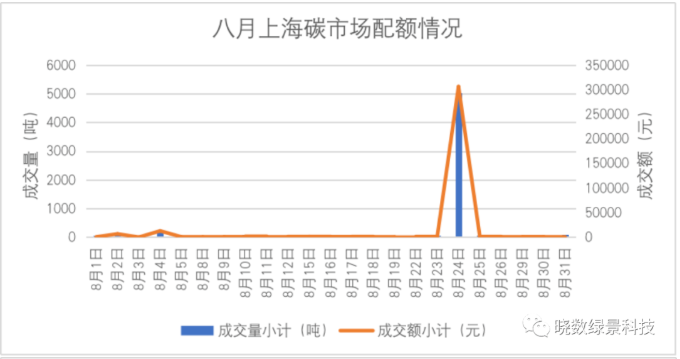
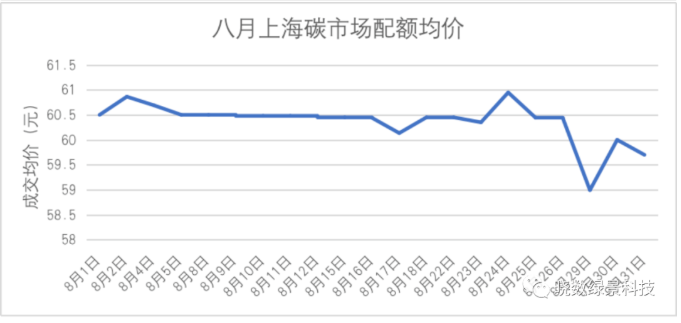
3. The overall situation of the Tianjin and Hubei carbon markets
The trading volume of allowances in the Tianjin carbon market this month was 961061 tonnes, and the turnover was 36391957 yuan.
The trading volume of allowances in the Hubei carbon market this month was 210955 tonnes, and the turnover was 9611241 yuan.
3. EU carbon market trading and policy information
1. Overall situation of the EU carbon market in August on a monthly basis
In August 2022, the EU carbon market price increased, and in the third week of August, the carbon price almost exceeded 100 euros/tonne. In terms of trading volume, the total trading volume of the futures market in August was 254,542 tons of carbon dioxide equivalent, and the trading volume in July was 299,922 tons of carbon dioxide equivalent, which was 15.13% lower than that in July, and the trading volume did not continue the growth trend in June and July. The average futures trading price in August was 88.50 euros/ton, an increase of 8.28% compared with 81.73 euros/ton in July, and the overall carbon price in August showed an upward trend, of which the futures price of 99.14 euros/ton on August 19 was the highest price in history since the European carbon market was traded; In August, the total spot trading volume of the EU carbon market was 1,072,000 tons of carbon dioxide equivalent, and the trading volume in July was 501,000 tons of carbon dioxide equivalent, an increase of 113.97% compared with July, and a significant increase compared with the carbon trading volume in July; The average futures trading price in August was 88.15 euros/ton, up 8.37% from 81.34 euros/ton in July.
In August, due to the official implementation of the EU carbon market to reduce the 15% natural gas policy, as well as the continued rise in natural gas prices caused by the maintenance of the "Nord Stream" pipeline in Russia, carbon prices maintained an upward trend in the first three weeks of August, and there was a downward trend in the fourth week but there was still an upward trend at the end of the session, and the overall carbon price rose steadily in August.
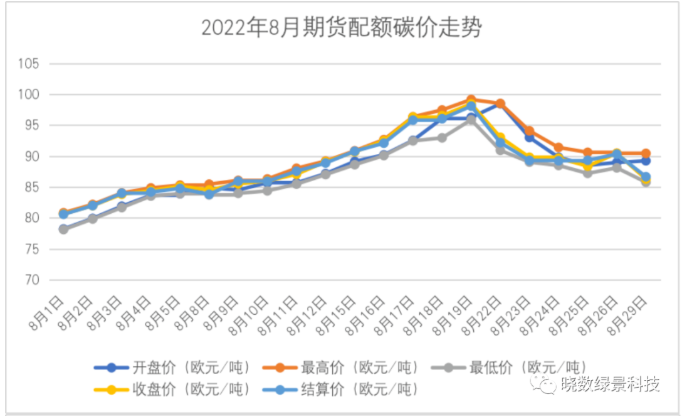

As can be seen from the chart below, the European market volume in August is still more favored by the market than the futures, because the allowance carbon price has risen sharply after a small peak in the third week, and there is a large spot volume in a single day on August 23. On the whole, it is still showing an upward trend.
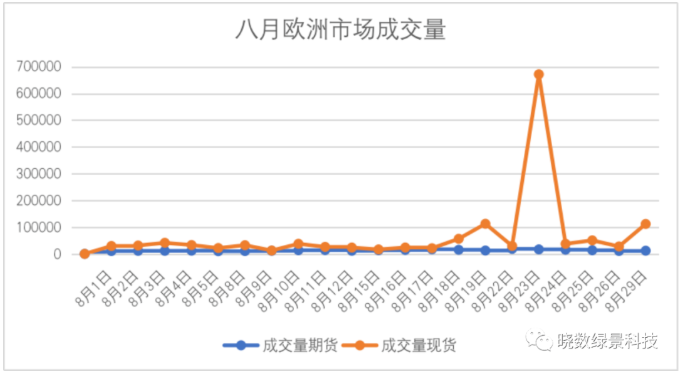
2. Monthly EU ETS policy information for August
Copenhagen, Denmark, has given up on its goal of achieving carbon neutrality by 2025
Sophie Andersen, mayor of Copenhagen, the capital of Denmark, said on the 22nd that Copenhagen is now abandoning the goal of achieving carbon neutrality by 2025 because an environmental protection company does not meet the government's funding standards for carbon capture. Andersen told the Danish Broadcasting Corporation on the same day: "We can't do it [by 2025], which is very irritating." I'm so sad. In 2009, the city of Copenhagen proposed to achieve carbon neutrality by 2025. To this end, the municipal government has formulated a series of action plans, including 50 specific projects, including vigorously developing green renewable energy such as wind energy, encouraging citizens to choose green travel, and promoting green and environmentally friendly buildings. According to the Danish Broadcasting Corporation, the city of Copenhagen now emits 80% less CO2 than it did in 2009. Source: Eco-China Network
Indonesia will introduce a carbon tax by the end of the year
Indonesia's government recently said it would introduce a carbon tax by the end of the year, the country's first steps to achieve carbon neutrality, and Indonesia will become the first developing country in Asia to impose a tax on emissions. The Indonesian government recently said that it will impose a carbon tax by the end of the year, which is the country's initial measure to achieve carbon neutrality, and Indonesia will become the first developing country in Asia to tax emissions, Polaris Carbon Steward Network has learned. Officials have previously said that a tax of Rp 30,000 per tonne of carbon dioxide equivalent (US$2.01) will initially be imposed on coal-fired power plants. It is equivalent to about 13.8 yuan. According to the carbon trading scheme in Indonesia's carbon tax roadmap, entities with emissions exceeding the cap will need to purchase an emission permit from another entity with emissions below the cap. Entities can also purchase emission reduction certificates. According to the plan, Indonesia will establish a carbon trading market in 2025. By 2030, Indonesia will reduce its greenhouse gas emissions by 29% within the framework of its Nationally Determined Contributions (NDCs) and aim to achieve its net-zero emissions target by 2060 or sooner.
Germany's approval of the winter energy saving policy will save around 10.8 billion euros
In the face of energy shortage, the German government approved winter energy-saving measures on the 24th, restricting heating and electricity consumption in public buildings, in order to reduce natural gas consumption by 2%. According to the new regulations, from September 1, except for hospitals and other institutions, the room temperature of public buildings after heating shall not exceed 19 degrees Celsius, and the entrance, corridor and foyer can be completely turned off for heating; Heating of private swimming pools and night lighting of shop facades are prohibited depending on the situation; Public buildings and monuments will no longer be lit up at night for purely aesthetic reasons. In addition, the German government intends to prioritise coal and oil cargo in rail transport, which means that passengers will have longer waiting times. According to the German Federal Ministry for Economic Affairs and Climate Protection, the approved energy-saving measures could save German households, the private sector and the public sector around 10.8 billion euros over two years. Source: Reuters
The energy giants' climate visions are at odds with the goals of the Paris Agreement
A study shows that the global decarbonization scenario envisioned by oil and gas majors does not align with the Paris Agreement's temperature targets to avoid catastrophic global warming. An international panel of experts analysed six emission scenarios from three European energy giants, Statoil, BP and Shell, as well as the International Energy Agency. The group said most of the emissions scenarios they assessed were listed as incompatible with the Paris Agreement targets because they failed to limit warming to "well below 2°C", let alone 1.5°C, and would well exceed the 1.5°C limit. This would undermine the Paris Agreement, and even a temporary rise of more than 1.5°C could lead to catastrophic effects, severely undermining the world's ability to adapt to climate change.
4. Policy information on the domestic carbon market
Nine departments including the Ministry of Science and Technology issued the "Implementation Plan for Science and Technology to Support Carbon Peak and Carbon Neutrality (2022-2030)"
On August 18, the Ministry of Science and Technology, the National Development and Reform Commission, the Ministry of Industry and Information Technology and other nine departments jointly issued the "Implementation Plan for Science and Technology to Support Carbon Peak and Carbon Neutrality (2022-2030)" (hereinafter referred to as the "Implementation Plan"), proposing a number of supporting technologies for green and low-carbon energy transformation, including new energy power generation, energy storage technology, hydrogen energy technology, etc.
"Scientific and technological innovation and policy innovation are two important aspects of achieving the goal of carbon peak and carbon neutrality, and both are indispensable." The relevant person in charge of the Ministry of Science and Technology said that in combination with the functions of the Ministry of Science and Technology, the "Implementation Plan" focuses more on scientific and technological innovation, focuses on strengthening the supply of high-efficiency and low-cost low-carbon technologies, and also gives due consideration to the content of policy innovation such as low-carbon technology standards to promote the industrialization of low-carbon technologies.
The Implementation Plan proposes 10 specific actions.
The National Development and Reform Commission, the National Bureau of Statistics and the Ministry of Ecology and Environment jointly issued the Implementation Plan for Accelerating the Establishment of a Unified and Standardized Carbon Emission Statistical Accounting System
In order to implement the "Opinions of the Central Committee of the Communist Party of China and the State Council on Completely, Accurately and Comprehensively Implementing the New Development Concept and Doing a Good Job in Carbon Peak and Carbon Neutrality" and the "Action Plan for Carbon Peaking Before 2030", and consolidate the foundation for carbon peak and carbon neutrality, the National Development and Reform Commission, the National Bureau of Statistics, and the Ministry of Ecology and Environment recently announced the "Implementation Plan for Accelerating the Establishment of a Unified and Standardized Carbon Emission Statistical Accounting System" (hereinafter referred to as the "Plan").
The plan proposes that by 2023, a departmental coordination mechanism with clear responsibilities, clear division of labor and smooth connection will be basically established, and a unified and standardized carbon emission statistical accounting system will be initially established. By 2025, the unified and standardized carbon emission statistical accounting system will be further improved, and the data quality will be improved in an all-round way, so as to provide comprehensive, scientific and reliable data support for carbon peak and carbon neutrality.
The plan clarifies four key tasks, including the establishment of a national and local carbon emission statistical accounting system, the improvement of the carbon emission accounting mechanism of industry enterprises, the establishment and improvement of carbon emission accounting methods for key products, and the improvement of the national greenhouse gas inventory compilation mechanism.
"Qiushi" magazine published an important article by General Secretary Xi Jinping "The whole party must completely, accurately and comprehensively implement the new development concept"
The 16th issue of Qiushi magazine published on August 16 will publish an important article by Xi Jinping, General Secretary of the CPC Central Committee, President of the People's Republic of China, and Chairman of the Central Military Commission, entitled "The Whole Party Must Completely, Accurately, and Comprehensively Implement the New Development Concept."
The article stresses that the new development concept is a systematic theoretical system, which answers a series of theoretical and practical questions about the purpose, motive force, method, and path of development, and expounds our party's political stance, value orientation, development model, development path, and other major political issues on development, and all must be completely, accurately, and comprehensively implemented in the new development concept.
Li Keqiang: Low-carbon development is related to the global green future, and innovation is the first driving force
Premier Li Keqiang sent a congratulatory letter to the 2022 Pujiang Innovation Forum on August 27.
Li Keqiang said that low-carbon development is related to the global green future, and innovation is the first driving force to lead development. In the face of the complex and profoundly evolving international and regional situation and the sluggish recovery of the world economy, the international community shares a common weal and woe. To develop the economy, improve people's livelihood and respond to climate change, all countries should not only base themselves on the present, but also look to the future, uphold the spirit of science and pragmatism, adhere to the path of openness and cooperation, promote the transformation of energy consumption and production mode in a stable and orderly manner, and strive to achieve the parallel and mutually reinforcing development and green transformation, and promote quality and upgrading.
Li Keqiang pointed out that as the world's largest developing country, China should take a low-carbon and green development path in the process of modernization, which has no precedent in human history and requires arduous efforts to achieve. Based on our own resource endowment, we will adhere to the principle of establishing first and then breaking down, and make overall plans, give full play to the supporting and leading role of scientific and technological innovation, promote the revolution of energy consumption, supply, technology and system, ensure energy supply, and promote the work of carbon peak and carbon neutrality in an orderly manner.
The Ministry of Ecology and Environment held a regular press conference in August
On August 23, the Ministry of Ecology and Environment held a regular press conference for August. Zou Shoumin, Director of the Department of Science, Technology and Finance of the Ministry of Ecology and Environment, attended the press conference and introduced the relevant situation of science and technology helping ecological environmental protection and high-quality development. Liu Youbin, spokesperson of the Ministry of Ecology and Environment, presided over the press conference, reported on the recent progress of key ecological and environmental protection work, and jointly answered questions from reporters.
At the meeting, it was proposed to actively promote the pilot work of climate investment and financing
In order to thoroughly implement the major strategic decisions of the CPC Central Committee and the State Council on carbon peaking and carbon neutrality, and to guide and promote more funds to be invested in the field of climate change, in accordance with the spirit of the Notice on Carrying out Climate Investment and Financing Pilot Work jointly issued by the Ministry of Ecology and Environment, the National Development and Reform Commission and other nine departments, and on the basis of comprehensive consideration of factors such as the basis of the local work to be declared, the willingness to implement and the effect of promotion and demonstration, 23 places have been selected as climate investment and financing pilots.
The People's Bank of China and other six departments issued the "Overall Plan for Chongqing to Build a Green Finance Reform and Innovation Pilot Zone"
The plan proposes that after about five years of efforts, Chongqing will basically establish a green financial system with diversified organizations, rich products, strong policies, safe and efficient market operation. Implement the concept of green development, refer to international green finance standards, and identify opportunities for green and low-carbon transformation in major industrial sectors. The green allocation of financial resources is smooth and efficient, the scale of green credit and green bonds has accelerated, the innovation of green financial products, tools and service models has been emerging, and the financing environment for green industries has gradually improved. Fintech and green finance have been deeply integrated, and the digital construction of green finance has achieved remarkable results. Explore cross-regional and cross-basin ecological compensation mechanisms, and promote the capitalization and transformation of regional ecological resources.
The plan mentions that the green financial market system should be cultivated and developed. For example, promote the development of the carbon finance market. Cultivate and optimize the carbon emission trading market, explore the system of paid use of initial allowances, develop carbon sinks in the agriculture and forestry industry, and explore the feasibility of financing businesses such as carbon asset quota repurchase and certified voluntary emission reduction replacement.
In addition, innovate the system of green financial products and services. Focusing on Chongqing's medium- and long-term green and low-carbon development plan, we will build a green financial product system. Eligible green projects will be included in the scope of local government bond support, support the issuance of innovative products such as green collective bonds and blue bonds for small and medium-sized enterprises, study and explore green asset-backed securities, and broaden green financing channels. Prudently carry out mortgage financing for environmental rights and interests, establish a market-oriented guarantee mechanism for the purchase and storage of collective forest rights, standardize the development of mortgage loans for collective forest rights, and study and explore the feasibility of issuing forest rights support notes.
Notice of the Ministry of Industry and Information Technology and other seven departments on printing and distributing the action plan for green and low-carbon development of the information and communication industry (2022-2025).
The plan requires that by 2025, the comprehensive energy consumption per unit of information flow will be reduced by 20% compared with the end of the 13th Five-Year Plan period, and the total comprehensive energy consumption per unit of telecommunication business will be reduced by 15% compared with the end of the 13th Five-Year Plan period, and 30 typical application scenarios of the information and communication industry will be selected and promoted to empower the whole society to reduce carbon emissions. The Plan proposes five major action tasks: optimizing the overall layout of green development, focusing on the green development of key facilities, promoting the construction of green industrial chain and supply chain, strengthening the supply capacity of the industry to empower economic and social green development, and strengthening the overall management of green development of the industry. The Plan also emphasizes the need to actively use existing funding channels to support the green and low-carbon development of the ICT sector. Give full play to the role of the national industry and finance cooperation platform, and promote financial institutions to provide diversified investment and financing support for green enterprises and projects. Promote the increase of green electricity supply, and study the deduction method between the use of green energy and carbon emissions of enterprises.







